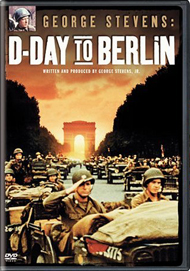| Release List | Reviews | Price Search | Shop | Newsletter | Forum | DVD Giveaways | Blu-Ray/ HD DVD | Advertise |
| Reviews & Columns |
|
Reviews DVD TV on DVD Blu-ray International DVDs Theatrical Reviews by Studio Video Games Features Collector Series DVDs Easter Egg Database Interviews DVD Talk TV DVD Talk Radio Feature Articles Columns Anime Talk DVD Savant HD Talk Horror DVDs Silent DVD
|
DVD Talk Forum |
|
|
| Resources |
|
DVD Price Search Customer Service #'s RCE Info Links |
|
Columns
|
 |
George Stevens - D-Day to Berlin
|
||||
The perfect time to release this film on DVD would have been 1998, four years after it was made; the authentic color footage of D-Day and the European campaign of 1944 would have complimented Saving Private Ryan and The Thin Red Line when they were the talk of the nation. The story is this: George Stevens started shooting 16mm Kodachrome home movies in 1938 on the set of Gunga Din, and when he took a combat filming unit into France with operation Overlord, he brought along his camera and a lot of film. As his handpicked crew of Hollywood professionals shot B&W 35mm combat footage, George recorded many of the same events with his 16mm color camera, mailing each individual roll back home for processing as it was exposed. According to his son George Stevens Jr, the finished rolls sat in the Stevens home for decades before he brought them out. After a screening, George Jr. realized they constituted the makings of a serious document. The first use for the footage appears to have been a segment in George Jr.'s George Stevens: A Filmmaker's Journey, but this short feature documentary consists exclusively of the wartime home movies with only a couple of minutes devoted to footage shot in the Stevens attic where the reels were found among the director's other keepsakes. In a way, it's a greatly 'extended version' of that docu chapter that stands well on its own. The skilled cameramen with Stevens' "irregulars" did terrific work on their straight newsreels, and Stevens' home movies are just as good. It does look as though these Kodachromes sat on a cool shelf for thirty years, as they're completely unscratched. The only drawback is that they were exposed at (I'd say) 18 frames a second, and because this show was finished on film, some of the shots look a little sped-up. Stevens' knack for cutting through red tape served him well in Hollywood (it's the most important, least-discussed skill around here) but was instrumental in his filming. In the Army, everything not covered by procedure is always a big 'no', but Stevens' cameras are there for a number of major events, as if his tiny unit carried an All Access Pass to WW2. They miss the initial Normandy landings by a few days ( a bit of B&W fills in there) but are soon speeding across France in jeeps, armed with the rest of the troops and staying right up with the front lines. They make sure they're on hand for a meeting of the big brass, where we get great footage of Generals Montgomery, Patton and Bradley. They're on hand for the liberation of Paris, and cameras roll while a straggling German sniper opens fire on the celebration. There is footage of the Battle of the Bulge, and in Germany they rush to a captured airfield to examine an experimental German jet. Stevens clearly responded to every hint of something notably filmworthy; he's on hand for the meeting of the West and the Soviets at the river Elbe. For a sobering ending, Stevens documents the liberation of Dachau, an experience that his son claims changed his outlook on life. For part of 1945 and 1946, Stevens would lend his film expertise to assembling German atrocity footage of the camps as documentation for use at the Nuremberg trials. It's an intense 46 minutes, with color so clear it looks as if the pictures came out of a time machine. Stevens' unit travels with guns at the ready and is clearly living off the land, although they appear to be able to shave regularly. One of the most touching pieces of film shows the director unwrapping a lovingly packaged Christmas package from home. Ivan Moffat and Irwin Shaw are in Stevens' irregulars, a wild crowd of unique wartime reporters. George Stevens Jr.'s narration script sticks to the facts and doesn't work on any side agendas, like hyping his father's fame or role in events. He does provide some interesting clues, like showing us the Dachau Post Office date stamp that the director angrily 'liberated' on his departure from the death camp. The interesting thing about Stevens is that his experience didn't turn him into a vengeful person. The rest of his filmic career would be dedicated to seriously-themed films and an interesting mix of politics that cannot be labeled entirely Liberal or Conservative. Stevens Jr.'s careful presentation of his father's life shows us an uncompromisingly ethical man. Warners' DVD of George Stevens - D-Day to Berlin has excellent color and sound to offset its short running time; there are no extras. Viewers looking for unique war footage will find a treasure trove, even though the stress here is not on vintage hardware or immediate combat coverage. It is possible that Warners were compelled to release this particular disc, along with George Stevens: A Filmmaker's Journey to get Stevens Jr.'s cooperation on their big-name Stevens films like Giant. Well-applied clout can sometimes bring about good things.
On a scale of Excellent, Good, Fair, and Poor,
George Stevens: D-Day to Berlin rates:
Review Staff | About DVD Talk | Newsletter Subscribe | Join DVD Talk Forum |
|
| Release List | Reviews | Price Search | Shop | SUBSCRIBE | Forum | DVD Giveaways | Blu-Ray/ HD DVD | Advertise |






